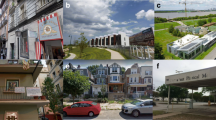Abstract
With the official designation of micropolitan areas in June 2003, as part of the new core-based statistical area system, non-metropolitan territory is no longer an undifferentiated residual. In this paper we compare the demographic and socioeconomic characteristics of a preliminary set of micropolitan areas with more highly urbanized territory and with territory outside core-based statistical areas, to answer questions about the micropolitan category's conceptual validity. Demographic and economic data are used, along with a mail survey of county officials in a random sample of small metropolitan, micropolitan, and non-core-based statistical areas (non-CBSAs). The analysis shows substantial differentiation between micropolitan and non-CBSA areas, and demonstrates the importance of distinguishing between these two types of non-metropolitan areas. As an intermediate category, micropolitan areas provide stability to the decade-to-decade swings in non-metropolitan population change during periods of higher out-migration, but share almost equally with non-CBSA areas in attracting migrants during periods of high non-metropolitan in-migration. In terms of services available and their function as urban centers, micropolitan areas are intermediate between small metropolitan and non-CBSA areas, but more similar to small metropolitan areas.
Similar content being viewed by others
References
Beale, C. (1984). Poughkeepsie’s complaint or defining metropolitan areas, American Demographics 6: 28-31, 46-48.
Berry, B. (1967). The geography of market centers and retail distribution. Englewood Cliffs, NJ: Prentice Hall.
Brown, D.L. & Cromartie, J.B. (2003). The nature of rurality in postindustrial society, pp. 269-284, in: T. Champion & G. Hugo (eds.), New forms of urbanization: Beyond the rural-urban dichotomy. Aldershot, England: Ashgate Publishers.
Brown, D.L. (1979). Metropolitan reclassification: Some effects on the characteristics of the population in metropolitan and non-metropolitan counties. Rural Sociology 44 (4): 791-801.
Cromartie, J.B. (2003). Measuring rurality: What is rural? Briefing room. U.S. Department of Agriculture, Economic Research Service. Available from <http://www.ers.usda.gov/briefing/Rurality/WhatisRural/> [August 20, 2003].
Dahmann, D. & Fitzsimmons, J. (eds.) (1995). Metropolitan and non-metropolitan areas: New approaches to geographical definition. Working paper No. 12. U.S. Census Bureau, Population Division.
Duncan, O., Scott, W., Lieberson, S., Duncan, B. & Winsborough, H. (1960). Metropolis and region. Baltimore: Johns Hopkins.
Fuguitt, G., Brown, D.L. & Beale, C. (1989). Rural and small town America. New York: Russell Sage Foundation.
Fuguitt, G., Heaton, T. & Lichter, D. (1988). Monitoring the metropolitanization process, Demography 25(1): 115-128.
Gras, N. (1922a). An introduction to economic history. New York: Harper Brothers.
Gras, N. (1922b). The development of metropolitan economy in Europe and America, American Historical Review 27: 695-708.
Hawley, A. (1971, revised 1981). Urban society: An ecological approach. New York: Ronald Press.
Hines, F., Brown, D. & Zimmer, J. (1975). The social and economic characteristics of the population in metropolitan and non-metropolitan counties, Agricultural Economics Report No. 272. Washington, DC: U.S. Department of Agriculture, Economic Research Service.
Jacobs, J. (1984). Cities and the wealth of nations. New York: Vintage Books.
Johnson, K.M. & Fuguitt, G.V. (2000). Continuity and change in rural migration patterns, 1950-1995, Rural Sociology 65(1): 27-49.
Ledebur, L. & Barnes, W. (1993). All in it together. Washington, DC: National League of Cities.
Morrill, R., Cromartie, J. & Hart, G. (1999). Metropolitan, urban, and rural commuting areas: Toward a better depiction of the United States settlement system, Urban Geography 20(8): 727-748.
Plane, D.A. & Henrie, C. (2002). Migration across the micropolitan/metropolitan spectrum, Paper presented at the annual meeting of the Western Regional Science Association, Monterrey, CA.
Rayer, S. & Brown, D.L. (2002). The demographic dimension of core-periphery linkages, Presented to the annual meeting of the Population Association of America, Atlanta, GA.
Sasson, S. (1994). Cities in a world economy. Thousand Oaks, CA.: Pine Forge Press.
Savitch, H., Collins, D., Sanders, D. & Markham, J. (1992). Ties that bind: Central cities, suburbs, and the new metropolitan region, Economic Development Quarterly7: 341-357.
Schnore, L. (1965). The urban scene. New York: Free Press.
Tilly, C. (1974). Urbanization, pp. 37-54, in: C. Tilly (ed.), Urban world. Boston: Little Brown.
Tilly, C. (1994). Entanglements of European cities and states, pp. 1-27, in: C. Tilly & W. Blockmans (eds.), Cities and the rise of states in Europe, A.D. 1000 to 1800. Boulder CO: Westview.
U.S. Census Bureau (1913). Thirteenth census of the United States. Vol. 1, Population 1910: General report and analysis. Washington, D.C.: U.S. Government Printing Office.
U.S. Office of Management and Budget (2000). Standards for defining metropolitan and micropolitan statistical areas, Federal Register 56(249): 82228-82238. Available from <http://www.whitehouse.gov/omb/fedreg/metroareas122700.pdf>.
U.S. Office of Management and Budget (2003). Revised Definitions of Metropolitan Statistical Areas, New Definitions of Micropolitan Statistical Areas and Combined Statistical Areas, and Guidance on Uses of the Statistical Definitions of These Areas. OMB Bulletin 03-04. Available from <http://www.whitehouse.gov/omb/bulletins/b03-04.html>.
Vias, A., Mulligan, G. & Molin, A. (2002). Economic structure and socioeconomic change in America’s micropolitan areas, 1970-1997, Social Science Journal 32: 399- 417.
Voith, R. (1992). City and suburban growth: Substitutes or complements? Business Review. Federal Reserve Bank: Philadelphia: 21-31.
Author information
Authors and Affiliations
Rights and permissions
About this article
Cite this article
Brown, D.L., Cromartie, J.B. & Kulcsar, L.J. Micropolitan Areas and the Measurement of American Urbanization. Population Research and Policy Review 23, 399–418 (2004). https://doi.org/10.1023/B:POPU.0000040044.72272.16
Issue Date:
DOI: https://doi.org/10.1023/B:POPU.0000040044.72272.16




